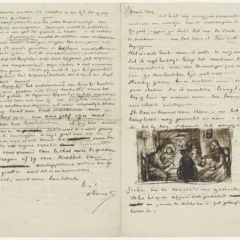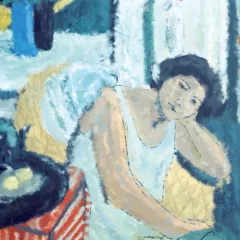Duchamp studies are a thriving industry in academe and his work continues to have a major influence on artists, so it was no surprise that the first annual Anne d’Harnoncourt Memorial Symposium at the Philadelphia Museum of Art (PMA), devoted to Duchamp’s final work, would attract a full house. The enthusiasm was such that by 10 am on Saturday morning (Sept. 12) the audience was seated and expectantly quiet.

The crowd for the event, co-sponsored by the Department of Art History at Penn and the PMA’s Center for American Art, included museum patrons, artists and art historians from the area as well as academics and museum staff from across the U.S. and Europe (Linda Henderson, Charlie Stuckey, Dawn Ades), dealers (Ron Feldman), notable artists (Mark Kostabi and Jeff Koons) and most of the Matisse family (Duchamp’s step-children). I had two house guests who came for the event: Dali scholar Frederique Joseph-Lowey and Kate Dempsey, a doctoral student at the University of Texas working on Ray Johnson (one of the artists responding to Étant donnés whose work is in the exhibition).
The symposium opened with a talk by Jeff Wall on Friday evening; speaking in the language of one well-versed in theory and criticism he described the influence of Duchamp’s career on his own. Wall said that in 1973 when he visited the PMA’s Duchamp retrospective he was in a crisis of several year’s duration, unable to produce work; he understood the importance of Duchamp’s readymades as a negation of the traditional artistic metiers and canon, but felt trapped by the Conceptualism which followed this stance. Seeing Étant donnés freed Wall to proceed with his own practice; he understood that Duchamp, unwilling to repeat the readymades and unable to proceed from them, finally returned to challenge the canon on his own terms.

Saturday’s papers ended with a discussion by Francis Naumann of the influence of Duchamp on the most recent paintings of Jeff Koons, so the academic papers were bookended by talks addressing Duchamp’s continuing importance for artists. Naumann began and ended by citing Picabia:
Our head is round to allow thought to change direction.
It was unclear whether this referred to Naumann’s changing understanding that Jeff Koons could be influenced by Étant donnés, or Koon’s own mental circling; but he did posit the novel suggestion that an artist’s intention (and hence acknowledgment of influence) could be established not only prior to or during the execution of a piece, but also at any time after its completion. Perhaps this follows Duchamp’s assertion that the viewer completes the work of art, the artist being the first viewer.

The papers in between included a discussion of Duchamp’s relationship with Mary Reynolds, his longest romantic involvement and collaborator on various book designs; a discussion of Duchamp’s attitude towards the concept of the oeuvre; the meaning of the inscription Hieronymous Duchamp in Frederick Kiesler’s photo collage of the artist in his studio (with jocular reference to the womanizing Duchamp’s frequent appeals to monastic seclusion); a long and complicated analysis of liberty in relation to Étant donnés by David Hopkins who began with the catchy but enigmatic statement that the nude in Étant donnés was metaphorically elevated, and literally violated; and how to reconcile Duchamp’s comment that he would not exhibit his work, according to his principles, with his ongoing activity as a curator of exhibitions by fellow artists.
The final event was a conversation between PMA curator, Michael Taylor and Duchamp’s step-son, Peter Matisse who worked with Anne d’Harnoncourt in 1969 to install Étant donnés in the PMA. On seeing the work in the artist’s studio after his death Matisse said he was most moved by the signs of Marcel’s personality, including the ad hoc and jerry-rigged construction of those parts hidden from public view. Duchamp had prepared a lengthy and detailed book of instructions for its installation (reproduced by the PMA and available in the museum’s shop), but Matisse acknowledged that he hadn’t even glanced at it; if he had, he said the installation wouldn’t have worked. Commenting on the symposium he said:
If Marcel could see this he’d be amused.










